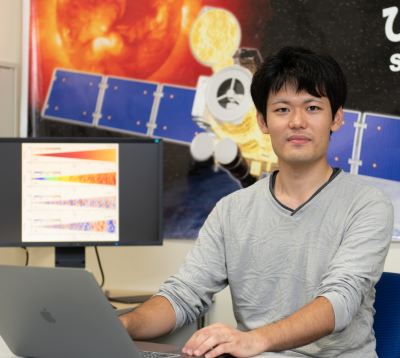Munehito Shoda Wins International Astronomical Union PhD Prize
Munehito Shoda (JSPS Research Fellow) at the Solar Science Observatory of the National Astronomical Observatory of Japan (NAOJ) was awarded the 2019 PhD Prize in the Solar and Heliospheric Division by the International Astronomical Union (IAU). This prize is awarded to one PhD student in each division by the International Astronomical Union to select the most remarkable work on astronomical research carried out in the previous year. Shoda received his PhD from the University of Tokyo's Graduate School of Science in 2019 for his doctoral dissertation entitled "Fast solar wind driven by parametric decay instability and Alfvén wave turbulence."

Photo: Munehito Shoda, the award recipient of the IAU PhD Prize. (Credit: NAOJ)
Shoda is attempting to elucidate the mechanism of plasma gas outflow from the Sun, known as "solar wind", using numerical calculations with a supercomputer. Solar wind is one of the most important solar activities, but its mechanism is still shrouded in mystery. In particular, the acceleration mechanism of the high-speed solar wind emitted from the high latitudes of the Sun is a big problem. Shoda performed the world's first three-dimensional magnetohydrodynamic simulation of the solar wind, showing that the interaction between shock waves and turbulence has a strong influence on the acceleration of the solar wind [Figure and Movie]. The calculations were carried out by NAOJ's supercomputer "ATERUI II", which is dedicated to astronomy, and are the largest simulation of the solar wind in the world. His research on the acceleration mechanism of the solar wind provides important information not only for the Sun, but also for stellar physics.
Shoda expresses his happiness and future aspirations, "I am pleased that my hard work while in the doctoral program has been recognized. I would like to express my deepest gratitude to the professors at the University of Tokyo for theirmy guidance; and I also thank the staff of NAOJ's Center for Computational Astrophysics for their generous provision of computational resources. Solar wind research is just now gaining in importance, so I would like to carry out more challenging research exceeding my current research."
The awards ceremony will be held in 2021 at the International Astronomical Union General Assembly in Busan, Korea, where the award certificate will be presented.
Figure and Movie: Three-dimensional magnetohydrodynamic simulation of solar wind near a solar pole. Given that the Sun is on the left, this figure shows the velocity of the plasma gas emitted from the Sun. The red color indicates faster speeds.The acceleration of the solar wind due to the pressure of the hot gas and the force of the magnetic field was simulated for the first time. (Credit: Shoda et al., 2019, ApJL modified.)
[Links of web sites for this topic]
- 2019 IAU PhD Prize Winners Announced(International Astronomical Union): https://www.iau.org/news/announcements/detail/ann20022/
- Recent News for the National Astronomical Observatory of Japan: https://www.nao.ac.jp/news/topics/2020/20200717-award.html
-
Press Release from the Center for Computational Astrophysics, NAOJ: https://www.cfca.nao.ac.jp/en/pr/20200717
Regarding the use of images and movies on the page concerned, please visit the page here. The credits of images and movies on this page are “NAOJ/JAXA” unless explicitly stated to the contrary. Regarding images and movies on this page the credits of which are “NAOJ/JAXA”, "NAOJ/JAXA/MSU", or “NAOJ, JAXA, NASA/MSFC”, terms of use for Copyrighted Works owned by NAOJ can be applied. In using the images and movies, the credits should be given.

